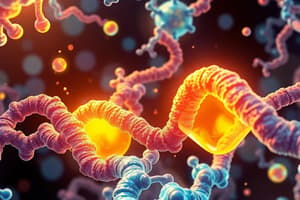Podcast
Questions and Answers
What is the primary role of the gla domain in prothrombin?
What is the primary role of the gla domain in prothrombin?
- It initiates the polymerization of fibrin monomers.
- It activates factor Xa during the clotting process.
- It enables prothrombin to bind to Ca2+ ions. (correct)
- It facilitates the binding of prothrombin to thrombin.
What is the significance of factor Xa in the conversion of prothrombin to thrombin?
What is the significance of factor Xa in the conversion of prothrombin to thrombin?
- It cleaves prothrombin at multiple sites simultaneously.
- It cleaves specific peptide bonds in prothrombin to activate it. (correct)
- It activates factor Va to enhance thrombin production.
- It stabilizes the connection between prothrombin and phospholipid membranes.
Which statement accurately describes the composition of fibrinogen?
Which statement accurately describes the composition of fibrinogen?
- It is a small glycoprotein with two subunits.
- It contains three non-identical chains: Aα, Bβ, and γ. (correct)
- It consists of six identical subunits.
- It is composed of three identical polypeptide chains.
What is the function of fibrinopeptides in the clotting process?
What is the function of fibrinopeptides in the clotting process?
What role does vitamin K play in the process of blood coagulation?
What role does vitamin K play in the process of blood coagulation?
What is the primary role of the catalytic site in an enzyme?
What is the primary role of the catalytic site in an enzyme?
Which of the following best describes the function of enzyme cofactors?
Which of the following best describes the function of enzyme cofactors?
How does the lock-and-key model explain enzyme-substrate interaction?
How does the lock-and-key model explain enzyme-substrate interaction?
What characteristic of enzymes allows them to catalyze highly specific reactions?
What characteristic of enzymes allows them to catalyze highly specific reactions?
Which statement about the transition state in enzyme-catalyzed reactions is correct?
Which statement about the transition state in enzyme-catalyzed reactions is correct?
What does the induced-fit model propose about the binding of substrates?
What does the induced-fit model propose about the binding of substrates?
Which factor does NOT influence the activity of enzymes?
Which factor does NOT influence the activity of enzymes?
What is the primary role of Asp102 in the enzymatic process described?
What is the primary role of Asp102 in the enzymatic process described?
Which statement about the formation of the tetrahedral intermediate is accurate?
Which statement about the formation of the tetrahedral intermediate is accurate?
What is the consequence of noncompetitive inhibition on enzyme activity?
What is the consequence of noncompetitive inhibition on enzyme activity?
How does His57 contribute to the reaction mechanism described?
How does His57 contribute to the reaction mechanism described?
What is the effect of the proton transfer from water to His57 in the reaction?
What is the effect of the proton transfer from water to His57 in the reaction?
What is meant by the 'charge relay system' mentioned in the context of the catalytic triad?
What is meant by the 'charge relay system' mentioned in the context of the catalytic triad?
What is the significance of the oxyanion hole in the enzymatic reaction?
What is the significance of the oxyanion hole in the enzymatic reaction?
During deacylation, what role does water play in the enzymatic process?
During deacylation, what role does water play in the enzymatic process?
What is the main effect of the second product formation in the enzymatic reaction?
What is the main effect of the second product formation in the enzymatic reaction?
Which statement describes the transition state in the context of this enzymatic mechanism?
Which statement describes the transition state in the context of this enzymatic mechanism?
What unique properties distinguish allosteric enzymes from typical enzymes?
What unique properties distinguish allosteric enzymes from typical enzymes?
In a Lineweaver-Burk plot, how is the Michaelis-Menten constant ($K_M$) determined?
In a Lineweaver-Burk plot, how is the Michaelis-Menten constant ($K_M$) determined?
What effect does an allosteric inhibitor have on an enzyme's active sites?
What effect does an allosteric inhibitor have on an enzyme's active sites?
How do allosteric activators influence enzyme function?
How do allosteric activators influence enzyme function?
Which of the following enzymes is an example of an allosteric enzyme?
Which of the following enzymes is an example of an allosteric enzyme?
What is the effect of cooperativity in allosteric enzymes?
What is the effect of cooperativity in allosteric enzymes?
In the context of enzyme regulation, what defines noncompetitive inhibition?
In the context of enzyme regulation, what defines noncompetitive inhibition?
What effect does noncompetitive inhibition have on Vmax?
What effect does noncompetitive inhibition have on Vmax?
How does noncompetitive inhibition affect Km?
How does noncompetitive inhibition affect Km?
In competitive inhibition, what change occurs in the required substrate concentration to achieve one-half Vmax?
In competitive inhibition, what change occurs in the required substrate concentration to achieve one-half Vmax?
What characteristic of allosteric enzymes is described by their reaction velocity dependence on substrate concentration?
What characteristic of allosteric enzymes is described by their reaction velocity dependence on substrate concentration?
Which amino acid is noted for its role in the His57 and Ser195 interaction within the serine protease catalytic triad?
Which amino acid is noted for its role in the His57 and Ser195 interaction within the serine protease catalytic triad?
What is the primary consequence of a competitive inhibitor on the Michaelis-Menten constant (Km)?
What is the primary consequence of a competitive inhibitor on the Michaelis-Menten constant (Km)?
In the presence of sufficient substrate for a competitive inhibitor, what is the effect on Vmax?
In the presence of sufficient substrate for a competitive inhibitor, what is the effect on Vmax?
Which feature is NOT associated with noncompetitive inhibition?
Which feature is NOT associated with noncompetitive inhibition?
What provides the mechanism for catalysis in serine protease?
What provides the mechanism for catalysis in serine protease?
What is the primary role of His57 in the catalytic action of serine proteases?
What is the primary role of His57 in the catalytic action of serine proteases?
Flashcards
Enzyme Active Site
Enzyme Active Site
The specific region of an enzyme where a substrate binds and the chemical reaction occurs.
Enzyme Substrate
Enzyme Substrate
The molecule that an enzyme acts upon and converts into a product.
Enzyme Specificity
Enzyme Specificity
Enzymes' ability to catalyze only specific reactions or classes of reactions.
Enzyme Cofactor
Enzyme Cofactor
Signup and view all the flashcards
Catalytic Site
Catalytic Site
Signup and view all the flashcards
Proteolytic Enzyme
Proteolytic Enzyme
Signup and view all the flashcards
Enzyme-Substrate Complex
Enzyme-Substrate Complex
Signup and view all the flashcards
Noncompetitive Inhibition
Noncompetitive Inhibition
Signup and view all the flashcards
Competitive Inhibition
Competitive Inhibition
Signup and view all the flashcards
Vmax
Vmax
Signup and view all the flashcards
Km
Km
Signup and view all the flashcards
Active Site
Active Site
Signup and view all the flashcards
Allosteric Enzyme
Allosteric Enzyme
Signup and view all the flashcards
Substrate
Substrate
Signup and view all the flashcards
Protease
Protease
Signup and view all the flashcards
Serine Protease
Serine Protease
Signup and view all the flashcards
Catalytic Triad
Catalytic Triad
Signup and view all the flashcards
Lineweaver-Burk Plot
Lineweaver-Burk Plot
Signup and view all the flashcards
Km on Lineweaver-Burk
Km on Lineweaver-Burk
Signup and view all the flashcards
Vmax on Lineweaver-Burk
Vmax on Lineweaver-Burk
Signup and view all the flashcards
Allosteric Regulation
Allosteric Regulation
Signup and view all the flashcards
Allosteric Enzyme
Allosteric Enzyme
Signup and view all the flashcards
Allosteric Activator
Allosteric Activator
Signup and view all the flashcards
Allosteric Inhibitor
Allosteric Inhibitor
Signup and view all the flashcards
Cooperativity
Cooperativity
Signup and view all the flashcards
Michaelis-Menten Kinetics
Michaelis-Menten Kinetics
Signup and view all the flashcards
Noncompetitive Inhibition
Noncompetitive Inhibition
Signup and view all the flashcards
Catalytic Triad
Catalytic Triad
Signup and view all the flashcards
Ser195 Oγ
Ser195 Oγ
Signup and view all the flashcards
His57
His57
Signup and view all the flashcards
Asp102
Asp102
Signup and view all the flashcards
Tetrahedral Intermediate
Tetrahedral Intermediate
Signup and view all the flashcards
Acylation
Acylation
Signup and view all the flashcards
Deacylation
Deacylation
Signup and view all the flashcards
Oxyanion Hole
Oxyanion Hole
Signup and view all the flashcards
Peptide Bond Hydrolysis
Peptide Bond Hydrolysis
Signup and view all the flashcards
Prothrombin activation
Prothrombin activation
Signup and view all the flashcards
Fibrinogen to Fibrin
Fibrinogen to Fibrin
Signup and view all the flashcards
γ-carboxyglutamate role
γ-carboxyglutamate role
Signup and view all the flashcards
Factor Xa's role in clotting
Factor Xa's role in clotting
Signup and view all the flashcards
Vitamin K's role in clotting
Vitamin K's role in clotting
Signup and view all the flashcards
Study Notes
Enzymes as Remarkable Catalysts
- Enzymes speed up important biochemical reactions
- Most enzymes are proteins, some are RNA
- Enzymes stabilize the transition state (highest energy species in reaction pathway)
- Work in specific temperature and pH ranges
Enzyme Catalyzed Reactions
- Reactants in enzyme catalyzed reactions are called substrates.
- Enzymes are highly specific. Examples are proteolytic enzymes that catalyze the hydrolysis of peptide bonds connecting amino acids.
The Active Sites of Enzymes
- Enzymes generally have two sites: catalytic and binding sites.
- The catalytic site is where the chemical reaction occurs.
- The binding site (often called the active site) is where the substrate binds to the enzyme, creating an enzyme-substrate complex. This binding is highly specific.
Cofactors and Enzyme Activity
- Enzyme cofactors (non-protein molecules or ions) assist enzymes in catalysis (chemical reaction acceleration).
- Coenzymes and metals are two types of cofactors
- An enzyme with its cofactor is called a holoenzyme, without it, the enzyme is called an apoenzyme.
Enzyme Kinetics
- The change in free energy (ΔG) of a reaction depends only on difference in free energy between reactants and products.
- ΔG does not provide information about the rate of the reaction.
- Enzymes increase the rate of a reaction by lowering the activation energy but do not change the equilibrium constant.
Michaelis-Menten Kinetics
- Plot of reaction velocity (Vo) against substrate concentration ([S]) shows maximal velocity (Vmax) is approached asymptotically.
- Michaelis constant (KM) is the substrate concentration achieving half-maximal velocity(Vmax/2)
- Most enzymes display Michaelis-Menten kinetics
Allosteric Regulation
- Allosteric regulation involves a regulatory molecule binding to an enzyme at a site other than the active site (allosteric site).
- This may involve noncompetitive inhibition, and/or competitive inhibition and/or cooperativity.
- Some allosteric enzymes show cooperative substrate binding and a sigmoidal curve.
Competitive Inhibition
- Inhibitor is similar in structure to the substrate and competes with the substrate for binding to the active site.
- Reaction is slowed/prevented
- KM increases, but Vmax remains the same.
Non-Competitive Inhibition
- Inhibitor binds to a site on the enzyme other than the active site (allosteric site)
- Inhibitor and substrate can both bind simultaneously to the enzyme
- Reaction is slowed/prevented
- KM remains the same, but Vmax decreases.
Proteases
- Proteases are enzymes that cleave peptide bonds.
- The mechanism involves a catalytic triad of amino acid residues.
- His57, Asp102, and Ser195 are crucial for function.
Blood Clotting
- Clotting factors (proteins) are inactive zymogens that become active enzymes via proteolysis
- The activation process involves intrinsic and extrinsic pathways converging on a common pathway.
- Factors include FIX, FVII, FX, and FII.
- Thrombin converts fibrinogen to fibrin, forming a clot.
- Vitamin K is a crucial cofactor in this process.
Classification of Enzymes
- Enzymes are classified into 6 basic groups based on the reaction they catalyze.
- Oxidoreductases, Transferases, Hydrolases, Lyases, Isomerases, and Ligases.
Studying That Suits You
Use AI to generate personalized quizzes and flashcards to suit your learning preferences.




